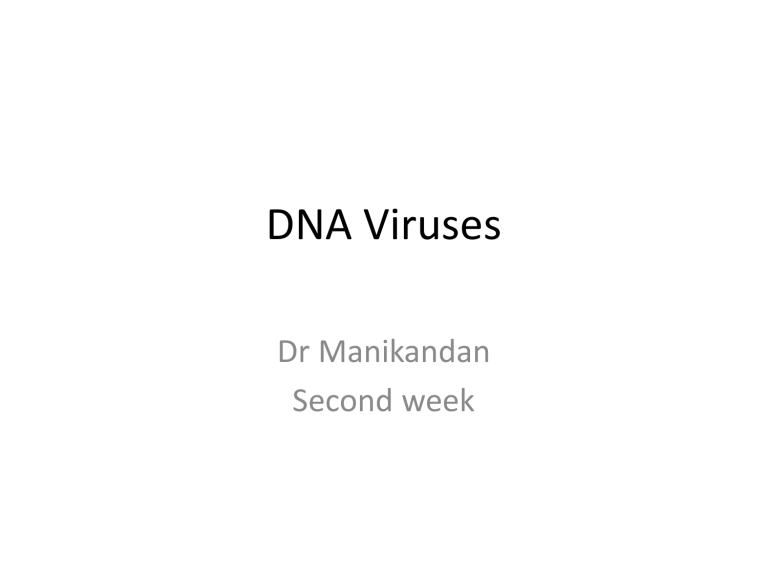2. DNA viruses

DNA Viruses
Dr Manikandan
Second week
Types of DNA containing viruses
• Viruses with Single-Stranded DNA Genomes
– only one family Parvoviruses
• Viruses with Double-Stranded DNA Genomes
– six families
Viruses with Single-Stranded DNA
Genomes
• contained in only one family
• Parvoviruses
• only human pathogen -
Parvovirus B19
• causative virus in erythema infectiosum (also known as
“slapped cheek syndrome” or the
“fifth disease”) in children
• causes aplastic crisis in anemic patients
• also contributes to joint diseases, embryopathies, and tissue rejection following renal transplants
Parvovirus
• parvoviruses are among the smallest viruses with a diameter of 19–25nm
• icosahedral, non-enveloped
• single-stranded DNA (ssDNA)
• Some parvoviruses can only replicate in the presence of a helper virus (adenovirus or herpesvirus)
• Parvovirus B19, the only human pathogenic parvovirus identified to date
• capable of autonomic replication, i.e., it requires no helper virus
Pathogenesis and clinical picture
• replicates in the bone marrow in erythrocyte precursor cells, which are destroyed in the process (patients already suffering from anemia (sickle-cell anemia, chronic hemolytic
Anemia)
• In healthy persons: usually run an asymptomatic course
• also cause a harmless epidemic infection in children (erythema infectiosum (“slappedcheek syndrome” or “fifth disease”)
Diagnosis
• Enzyme immunoassay reveals antibodies of the IgG and IgM classes
• During the viremic phase, at the onset of clinical symptoms, the virus can also be identified in the blood by means of electron microscopy or PCR
Epidemiology and prevention
• transmission route of human parvovirus B19 is not known
• Droplet infection or the fecal-oral route is suspected
Viruses with Double-Stranded DNA
Genomes
• Viruses with double-stranded DNA genomes are classified in six families:
1. papillomavirus,
2. polyomavirus,
3. adenovirus,
4. herpesvirus,
5. poxvirus,
6. Hepadnavirus
• Carcinogenic types have been found in all groups except the poxviruses
Papillomaviruses
• over 70 viral types in the genus
Papillomavirus
• all involved in the etiology of
benign tumors such as warts and
papillomas, as well as malignancies
• Malignancy - mainly in the genital area (cervical carcinoma)
• These organisms cannot be grown in cultures
• direct detection of the viral genome and histological analysis
• Serology is less important in this group
Warts Caused by Papillomaviruses
Characteristics
• diameter of 55 nm and contain an 8 kbp dsDNA genome
• two distinct regions within the circular genome:
• 1. codes for the regulator proteins produced early in the replication cycle
• 2. codes for the structural proteins synthesized later
• All Pappillomavirus induce either benign or
malignant tumors in natural or experimental hosts
Diagnosis
• cannot be cultivated in vitro
• detected and identified by histological analysis
• Malignancies - in-situ hybridization
• Antibody assay results have a low significance level
Epidemiology and prevention
• Since viruses are produced and accumulate in wart tissues, papillomaviruses are transmissible by direct contact
• Warts can also spread from one part of the body to another (autoinoculation)
• A certain level of prophylactic protection can be achieved with hygienic measures
Polyomaviruses
• medically important polyomavirus
• JC virus, causes progressive multifocal
leukoencephalopathy (PML), a demyelinating disease (damage of myelin sheath of neurons) that has become more frequent as a sequel to
HIV infections, but is otherwise rare
• BK virus, which affects bone marrow transplantation patients.
• Electron microscopy or PCR are the main diagnostic tools
Characteristics
• polyomaviruses can be divided into two groups:
• Group 1: SV40 and SV40-like
viruses such as human pathogen
JC (Patient_John Cunningham) and BK viruses
• Group 2: polyomaviruses such as the carcinogenic murine polyomavirus viral nucleus in the host cell (TEM)
• The designations JC and BK are the initials of the first patients in whom these viral types were identified
• The name polyoma refers to the ability of this organism to produce tumors in many different organs
Pathogenesis and clinical picture
• The JC and BK viruses are widespread
• over 80% of the adult population show antibodies to them
• The viruses can be reactivated by a weakening of the immune defense system
• The JC virus attacks the macroglia (cell in the
CNS), especially in AIDS patients (fatal within one
year)
• The BK virus can cause hemorrhagic cystitis in bone marrow transplantation patients
Diagnosis
• JC and BK viruses can be grown in cultures
• Both can be detected with PCR and the BK virus can be seen under the electron microscope in urine
• Antibody assays are practically useless due to the high level of generalized contamination






